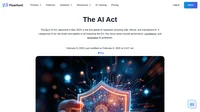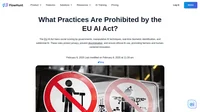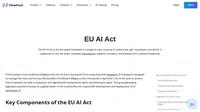Overview of the Penalty Framework
The EU AI Act sets up a tiered penalty system to address different levels of violations and promote compliance with its strict regulations. The fines are scaled based on the seriousness of the offense, ensuring AI system operators and developers are held accountable. There are three main categories: severe violations, high-risk violations, and other non-compliance issues. Each category aligns specific obligations with corresponding penalties, using the proportionality principle to avoid excessive burdens on Small and Medium Enterprises (SMEs).
Severe Violations: Up to €35 Million or 7% of Global Turnover
The harshest penalties apply to prohibited practices defined in the EU AI Act. These include deploying AI systems that exploit user vulnerabilities, use subliminal techniques to manipulate behavior, or implement real-time biometric identification in public spaces against the rules. Organizations involved in these actions can face fines of up to €35 million or 7% of their global annual turnover, whichever is greater.
For example, the use of AI for social scoring by public authorities, which can lead to unfair discrimination and harm fundamental rights, qualifies as a severe violation. These penalties enforce the ethical principles that underpin AI development and usage.
High-Risk Violations: Up to €20 Million or 4% of Global Turnover
High-risk AI systems must meet strict requirements, including conformity assessments, transparency measures, and risk management protocols. Failing to meet these requirements can result in fines of up to €20 million or 4% of global turnover.
High-risk systems are often used in critical fields like healthcare, law enforcement, and education, where errors can have significant impacts. For example, an AI recruitment tool that demonstrates algorithmic bias and leads to discriminatory hiring decisions would fall into this category. These penalties ensure that high-risk systems prioritize fairness, accountability, and transparency.
Other Non-Compliance: Up to €10 Million or 2% of Global Turnover
The lowest tier of fines applies to less serious violations, such as administrative errors, incomplete documentation, or failure to meet transparency requirements for limited-risk AI systems. Organizations found guilty of these infractions may face fines of up to €10 million or 2% of their global turnover.
For example, if an organization fails to inform users that they are interacting with an AI system, as required for limited-risk applications like chatbots, it could face penalties under this category.
Proportionality for SMEs
To maintain fairness, the EU AI Act adjusts penalties for SMEs using the proportionality principle. Fines for smaller organizations are calculated on the lower end of the scale to prevent overwhelming financial strain. This ensures that businesses of varying sizes can operate within the AI ecosystem while meeting regulatory standards.
Prohibited Practices and Criteria for Violations
You need to understand the prohibited practices under the EU AI Act if you want to ensure your organization’s AI systems follow the regulation’s strict ethical and legal guidelines. Article 5 of the Act clearly defines practices that are unacceptable because they can harm individuals or society. These rules help promote the development of trustworthy AI while protecting democratic values and human rights.
Subliminal Manipulation Techniques
The EU AI Act bans the use of AI systems that manipulate people below the level of their conscious awareness. These techniques are designed to influence behavior in ways that stop individuals from making informed decisions. AI systems like these are prohibited if they cause or could cause physical or psychological harm to individuals or groups.
A clear example is AI-driven advertisements that exploit psychological weaknesses to pressure people into buying things they didn’t plan to. By outlawing such methods, the EU AI Act focuses on protecting individual autonomy and well-being.
Exploitation of Vulnerabilities
AI systems that take advantage of vulnerabilities related to age, disability, or socio-economic conditions are not allowed. These systems exploit specific weaknesses in individuals or groups, leading to harm or distorted decision-making.
For instance, an AI-based loan application system that targets financially vulnerable individuals with predatory lending options violates this rule. This ensures fairness and prevents unethical practices in the use of AI.
Social Scoring Systems by Public Authorities
The Act strictly forbids public authorities from using AI to create social scoring systems. These systems assess individuals based on their behavior or predicted traits, often leading to unfair or discriminatory treatment.
An example would be a social scoring system denying someone access to public services based on their perceived behavior. Such practices are deemed incompatible with democratic values and basic human rights.
Unauthorized Use of Real-Time Biometric Identification Systems
The EU AI Act imposes strict limits on the use of real-time biometric identification systems in public spaces. These systems can only be used in exceptional cases, such as finding missing persons or addressing immediate threats like terrorist activities. Using these technologies without proper authorization is considered a breach of the law.
Unauthorized examples include facial recognition systems used for large-scale surveillance without a valid legal reason. These restrictions aim to avoid the misuse of sensitive biometric data and to safeguard privacy and personal freedoms.
Criteria for Determining Violations
When assessing violations of the prohibited practices, the EU AI Act considers the potential harm and social impact. Key factors include:
- Intent and Purpose: Whether the AI system was created or used with the goal of manipulating, exploiting, or harming individuals.
- Impact on Fundamental Rights: How much the AI practice interferes with rights like privacy, equality, and personal autonomy.
- Severity of Harm: The level of physical, psychological, or societal harm caused by the AI system.
For example, an AI system that causes harm unintentionally due to technical errors may face less severe penalties compared to one intentionally designed to exploit users.
Enforcement Mechanisms of the EU AI Act
The EU AI Act lays out clear enforcement measures to ensure adherence to its rules, protect fundamental rights, and encourage the growth of reliable AI. It relies on collaboration between national authorities, market surveillance bodies, and the European Commission. Below, you will find an explanation of the main enforcement frameworks, including the roles of national authorities, monitoring and reporting duties, and transparency requirements.
National Authorities
National authorities play a central role in enforcing the EU AI Act within their respective Member States. Their responsibilities include:
- Establishing AI Governance Systems: Member States need to create governance frameworks that monitor compliance with the Act. This involves setting up oversight committees and designating competent bodies to oversee AI applications.
- Conducting Compliance Assessments: These authorities will check whether AI systems comply with the Act’s requirements, focusing on high-risk applications. This process includes reviewing documentation, performing audits, and ensuring systems meet EU standards.
- Imposing Sanctions: When organizations fail to meet the Act’s requirements, national authorities can impose penalties, such as monetary fines outlined in the Act. This mechanism ensures organizations are held accountable.
These tasks must follow specific deadlines. For example, Member States are required to establish AI governance systems by mid-2026, in line with the Act’s full implementation.
Monitoring and Reporting Obligations
The EU AI Act requires thorough monitoring and reporting to maintain control over AI systems used in the market. These obligations include:
- Post-Market Surveillance: Developers and users of AI systems must monitor how their systems perform after deployment. They are responsible for identifying and addressing any risks or issues that could cause harm.
- Incident Reporting: Serious incidents or breaches of the Act must be reported to national authorities within a defined timeframe. This allows for quick intervention to reduce risks and protect individuals.
- Compliance Documentation: Organizations need to keep comprehensive records of their AI systems, such as risk assessments and conformity checks. These documents must be accessible to authorities upon request for inspection.
Transparency in Documentation and Risk Assessments
Transparency forms a key part of the EU AI Act’s enforcement approach. It ensures that AI systems are open to scrutiny, and their developers and users can be held accountable. Key transparency measures include:
- Public Disclosures: Developers of high-risk AI systems must provide information about their system’s purpose, functionality, and limitations. This helps users make informed decisions and be aware of potential risks.
- Risk Management Frameworks: Organizations must develop solid risk management frameworks. These frameworks should identify, assess, and address risks related to their AI systems. Authorities will review these frameworks to ensure compliance.
- Detailed Technical Documentation: Detailed documentation is required to prove compliance with the Act. This includes information about the system’s design, algorithms, and data sources.
Real-World Implications and Examples of EU AI Act Fines
The EU AI Act enforces strict rules on how AI is used and introduces heavy fines for violations. These measures aim to prevent misuse and ensure organizations comply. This section looks at real-world examples, explains prohibited practices, and outlines why organizations need to follow these regulations whether they operate inside or outside the EU.
Examples of Prohibited AI Practices
The EU AI Act lists specific AI practices as illegal because they can harm individuals or society. These examples warn organizations about what technologies to avoid or carefully control.
- Subliminal Manipulation Techniques: AI systems that influence human behavior without users being aware of it are banned. For example, an AI tool used in advertising to subtly push people into making purchases without realizing it would violate the law. A retailer using such technology could face fines of up to €35 million or 7% of their global annual revenue.
- Exploitation of Vulnerabilities: AI systems targeting vulnerable groups, like children or the elderly, are prohibited. For instance, an educational AI tool designed to mislead children by exploiting their limited understanding could lead to penalties.
- Unauthorized Use of Biometric Systems: Using real-time biometric systems, such as facial recognition in public spaces, without proper authorization is forbidden. An example would be deploying facial recognition for mass surveillance in public areas, which could result in severe fines.
- Social Scoring by Public Authorities: Assigning individuals scores based on their social behavior, resembling systems used in some countries, is illegal. This practice violates EU principles as it can lead to discrimination and worsen social inequality.
Lessons for Organizations
Breaking the EU AI Act can lead to more than financial penalties. It can harm a company’s reputation, erode consumer trust, and lead to legal challenges. Organizations need to take proactive steps to comply with the regulations and reduce these risks.
- Risk Assessments: Businesses should routinely evaluate their AI systems to find and address compliance issues.
- Transparency Practices: Keeping clear records and ensuring transparency in AI operations can protect organizations from accusations of wrongdoing.
- Investment in Ethical AI: Putting resources into ethical AI development helps meet compliance requirements while improving brand image and earning consumer trust.
Compliance and AI Innovation
Meeting the EU AI Act’s requirements is more than a legal necessity. It also supports innovation by creating safer, more reliable AI systems. Organizations that follow the rules can access new markets and build stronger partnerships.
For companies operating internationally, compliance is especially important because the Act applies to non-EU organizations offering AI systems in the EU. This global reach means businesses need to align their practices with EU regulations to stay competitive.
Chatbots under the European AI Act
Discover how the European AI Act impacts chatbots with key compliance rules, risk categories & deadlines. Stay informed to build ethical AI!"
What Practices Are Prohibited by the EU AI Act?
Discover prohibited AI practices under the EU AI Act, including bans on social scoring, manipulative AI, and real-time biometric systems.




